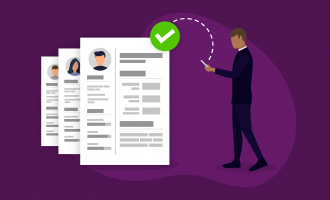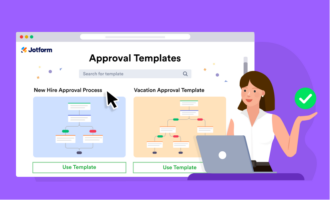Top 12 functions of HR management
- Recruitment and hiring
- Onboarding and ongoing training and development
- Managing employee and employer relationships
- Creating a rewarding company culture
- Overseeing disciplinary action
- Employee training
- Employee engagement
- Performance management
- Policy development
- Change management
- People strategy
- Diversity and inclusion
The functions of human resource management are designed to recruit potential employees, hire and train them, and then support them in improving their performance so they can reach their full potential and help the organization achieve its targets. Put simply, it’s important to find the right people, develop their skills over time, and create an environment where they can do their best work.
No matter the industry or the size of the organization, human resource management plays a lead role in the success of businesses and their people. Here are several functions of this people-focused management function.
1. Recruitment and hiring
One of the most well-known functions of human resource management is recruitment and hiring. To remain competitive in the industry, businesses need to attract and retain top talent.
The HR team typically meets with a hiring manager to learn more about open positions and gain a detailed understanding of the kind of people that will fit best in those roles. While they also consider education, experience, and skills, HR must look at personality traits and working styles to increase the chances of long-term compatibility.
A strategic HR department has a long-term recruiting and hiring plan that aligns with the company’s growth goals. This plan includes creating job postings and sharing them through their networks, screening incoming applications, conducting interviews, performing reference and background checks, and finalizing hiring paperwork.
2. Onboarding and ongoing training and development
Once a company hires employees, it’s vital to properly onboard and train them so they have the tools to excel in their roles. Human resource management provides onboarding for new employees, which can include sharing the company mission, vision, and values, in addition to internal policies and procedures. It may also include safety training, depending on the workplace.
In addition to onboarding, HR also facilitates ongoing professional development through training, seminars, workshops, and certifications. They may create internal training or outsource it to training experts. Investing in employees’ professional development helps build loyalty and reduce turnover, not to mention increasing performance and productivity.
3. Managing employee and employer relationships
A company’s success relies on its people, so human resource management must focus on fostering healthy relationships among all levels of employees.
This can include conflict resolution during tense situations or negotiating positive outcomes for all involved parties. It may also include providing specific types of training, such as anger management or mindfulness, to ensure employees have the resources to manage themselves effectively in the workplace.
4. Creating a rewarding company culture
One of the most overlooked functions of human resource management is developing an engaging company culture. Keeping employee morale high doesn’t happen only during team lunches or after-work drinks. It happens through the ethos of the company — the mission, vision, and core values.
Another HR responsibility includes making sure employees have competitive pay and both tangible and intangible benefits. The department should identify potential negative workplace cultural issues that could create problems among employees and help steer the organization in the right direction.
5. Overseeing disciplinary action
A difficult aspect of human resource management is disciplining employees when required. HR professionals must have a disciplinary process in place and must ensure all employees are aware of it as part of their onboarding.
If an incident occurs that requires disciplinary action, HR may need to notify the employee with a written warning and include it in their file. It may even be necessary to suspend, demote, or terminate the employee, depending on the issue. It’s best to have a legal expert on the HR team who can ensure the company follows all labor laws properly in terms of disciplinary actions.
Functions of human resource management can also include meeting compliance regulations and industry safety standards, maintaining the integrity of employee data, and overseeing employee benefits. Above all, the goal is to support employees in performing to their full potential to help the company reach its objectives.
6. Employee training
Another primary function of human resource management is to provide opportunities to develop employees’ skills and knowledge. This includes providing sufficient training materials, creating a help desk for employee questions and troubleshooting, or even integrating a learning management system (LMS) for new employees.
“Training and development programs are designed to improve employee skills and ensure that they can meet the demands of their jobs,” explains Jessica Carrell, cofounder of AnySoftwareTools. “These programs typically include on-the-job training, workshops, seminars, and other training activities.”
Training not only boosts employee skills and performance, but it also increases employee motivation and reduces turnover. “A well-trained employee is more productive, efficient, and capable of handling complex tasks,” says Carrell.
7. Employee engagement
Employee engagement involves creating a positive work environment that motivates employees and fosters connectedness across the workforce. According to Michael Chen, growth director at Notta, organizations can achieve these benefits through various initiatives such as employee recognition programs, wellness programs, and employee feedback mechanisms.
“The ultimate result of successful employee engagement is to promote job satisfaction, reduce turnover, and ultimately improve organizational performance,” says Chen.
Another way of engaging employees with the company is featuring and promoting them externally. Obviously each employee is an expert in at least one area, so for a company which has a blog section, this expertise is actually an opportunity.
The employees can write blog posts about their expertise and the companies can publish them in their blog pages. That way you can both improve your blog content with original content and also let the employee show off his/her skills. That might be another way of increasing the dedication and engagement of an employee to the company.
8. Performance management
Another HR-related function is performance management, which involves setting performance expectations, providing feedback, measuring employee performance, and monitoring progress to ensure that employees do their part to meet organizational goals.
“The focus in this function is to improve employee performance, increase productivity, and align employee goals with organizational goals,” Carrell explains. “To underpin your efforts in this area, offer rewards or dole out consequences based on performance.”
9. Policy development
“Human resource management is also concerned with policymaking, especially policies that involve employee wellness,” says Steve Mostyn, chief human resources officer of Management Library. Policymaking is a very important task of HR, as the department has a unique viewpoint that enables them to see how policies can help the company overall, as well as employees in particular.
10. Change management
LynnAnn Brewer, director of HR research and advisory services at McLean & Company, says HR should also play a leading role in any ongoing change management efforts.
“It’s critical for HR to know how to plan for change and recognize how change aligns with the organization,” says Brewer. “The department will need to design for change by being transparent and consistent with communication and developing employees to build change management capabilities.”
Brewer notes that HR teams can build the capacity for managing change across the organization by supporting key aspects of change projects and offering change management expertise. “Key organizational stakeholders need HR’s support to lead the people side of change, lead project teams, function as the face of change, share key messages, and deliver training to support change.”
11. People strategy
“In an increasingly complex and competitive market, organizational leaders must move away from relying on gut feelings and toward making data-driven, evidence-based strategic decisions about its workforce,” says James Kim, a senior consulting analyst at McLean & Company.
People are the lifeblood of any organization, and companies must take a strategic approach in managing and developing them — just as they would with any other aspect of an organization. To inform this strategy and improve decision-making practices within HR, Kim recommends making use of people analytics — the process of analyzing employee or workforce data to produce actionable insights that will enhance the employee experience or organizational outcomes.
“Data can be gathered at all points across the employee lifecycle — talent acquisition, onboarding, learning and development, and employee exiting,” Kim explains. “Advanced forms of people analytics can be used to predict key outcomes about the workforce, such as turnover and skill gaps, to preemptively prepare for and address these areas and position the organization ahead of the competition.”
12. Diversity and inclusion
A more recent addition to the functions of human resource management is diversity and inclusion, which focuses on creating an environment where all individuals can thrive and contribute to their full potential regardless of their identity, background, or circumstance.
“Diversity and inclusion involves implementing diversity training programs, creating inclusive policies and practices, and fostering a culture that values and respects differences,” says John Sanei, future strategist and transformation specialist. “For example, HR might establish employee resource groups (ERGs) for underrepresented groups, which provide support, enhance career development, and contribute to personal development in the work environment.”
Functions of human resource management can also include meeting compliance regulations and industry safety standards, maintaining the integrity of employee data, and overseeing employee benefits. Above all, the goal is to support employees in reaching their full potential to help the company reach its objectives.














































Send Comment:
3 Comments:
More than a year ago
Yes, this article benefits me and provides much more knowledge about the HRM and about their role in ensuring that an organization's human capital is effectively utilized to achieve its goals and objectives
More than a year ago
Good
More than a year ago
The info above was very helpful to me in improving my work
Thank you